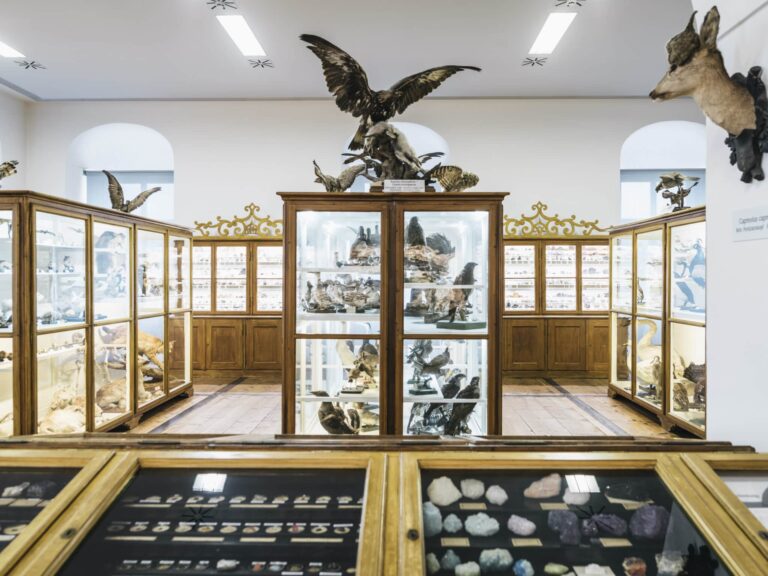Natural history
The Natural History Museum of Admont Abbey
"The museum within the museum"
COLLECTIONS
The Natural History Museum was rebuilt between 1866 and 1906 by the 20-year-old Admont Benedictine Father Gabriel Strobl after the devastating abbey fire in 1865. In his scientific work, Strobl built up a huge insect collection with around 252,000 specimens.
The collection of dipterans alone, with more than 50,000 specimens, is one of the most important collections in Europe. Through his own collecting, swaps, purchases and donations, Father Gabriel Strobl acquired the collections that can be marvelled at today in the partially redesigned Natural History Museum during his 44 years of work.

Remodelling and redesign
During the renovation and redesign of the museum landscape at Stift Admont, the premises of the Natural History Museum were also renovated and ceremoniously opened on May 2, 2004. At the outset, you enter the world of reptiles and amphibians: a over two-meter-long Mississippi alligator, specimens of dried and preserved snakes, lizards, and turtles. A "cabinet-row" provides information about the historical development of the Natural History Museum.The first side room is dedicated to the scientific and artistic achievements of Father Gabriel Strobl. On the walls, there is an exhibit of various groups of insects.
Insect collection
The insect collection is of particular importance: especially the collection of diptera, which Father Gabriel Strobl collected more than 100 years ago. This collection is still the subject of research today. There are contacts with international institutes and recognised experts are working on further research and detailed typifications.
Scientific works and newly written books, especially by Milan Chvála, prove the value of the impressive collection in the professional world.
Wax fruit from Father Constantin Keller
The second side room presents all 243 exhibits of wax fruit by Father Constantin Keller (1778-1864) in an impressive installation. The room itself takes on the shape of a fruit thanks to a curved display case construction. It houses the artistic unique specimens, which Father Constantin moulded in wax from originals he had grown himself.
The wax fruits are of the highest quality and correspond almost perfectly to their natural counterparts. They also include fruit varieties that have largely disappeared from existing ranges today. Read more about the wax fruit collection of Fr Constantin Keller.

The passion of researchers
A collaborative project between the Gesäuse National Park and Admont Abbey can be experienced in the third side room. The permanent exhibition aims to awaken visitors' emotions for nature, and specifically for the nearby Gesäuse National Park, through the researchers' passion.
In the second corridor hall
The second gallery corridor contains specimens of creatures from the various natural realms that live in the elements "Earth, Air and Water": European butterflies with dried and pressed examples of cryptogams (plants that reproduce by spores) are on view in historical display cases along the right wall and reflect the harmonious coexistence of plants and animals. The third living environment ‒ "Water" ‒ is represented here by a collection of conch shells and preserved fishes.
The so-called "Lion Room" has been preserved in its historical ambiance and earned its name due to a large East African lion specimen acquired by Father Gabriel Strobl from the renowned Africa explorer Emil Holub. Valuable exhibits, primarily of exotic mammals and birds, are housed in the historical display cases.
The South-eastern Pavilion
The conclusion of this "nature walk" is marked by the so-called "Southeast Pavilion" with a magnificent view of the National Park area. This formerly sole room of the Natural History Museum features, in addition to an extensive collection of rocks and minerals, a colorful display of European and local mammals and birds.
With Father Gabriel Strobl (1846-1925), who, as the curator of the Natural History Museum, primarily focused on botany in his first 12 years of work and then dedicated the next 32 years to the field of entomology (insect science), Admont Abbey gained significant importance in scientific research. Monasteries were often places of knowledge and education overall. The Benedictine Abbey of Admont strives to continue this heritage to the best of its ability, aiming to preserve our environment as part of the creation entrusted to our care.









